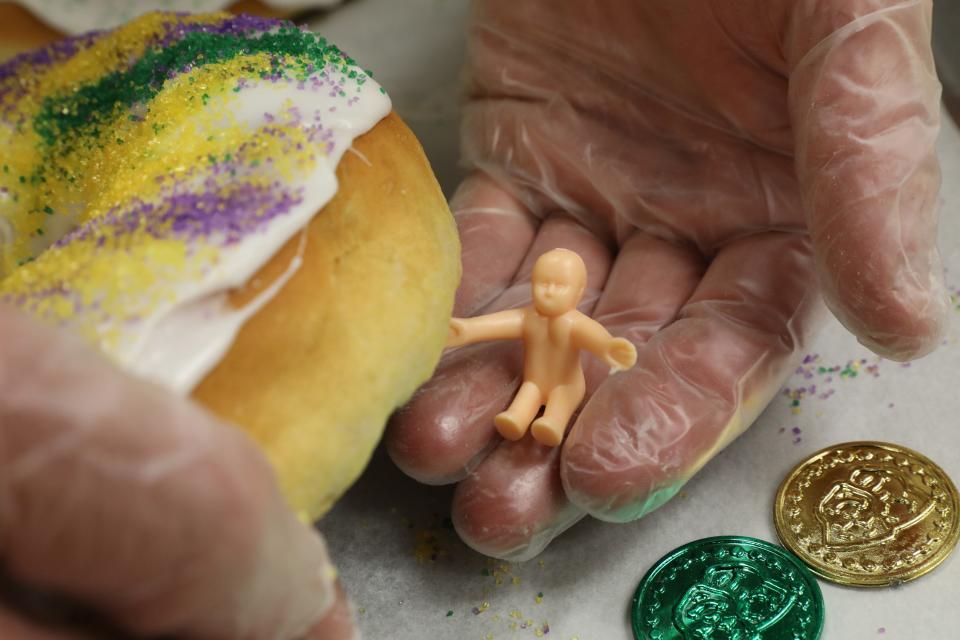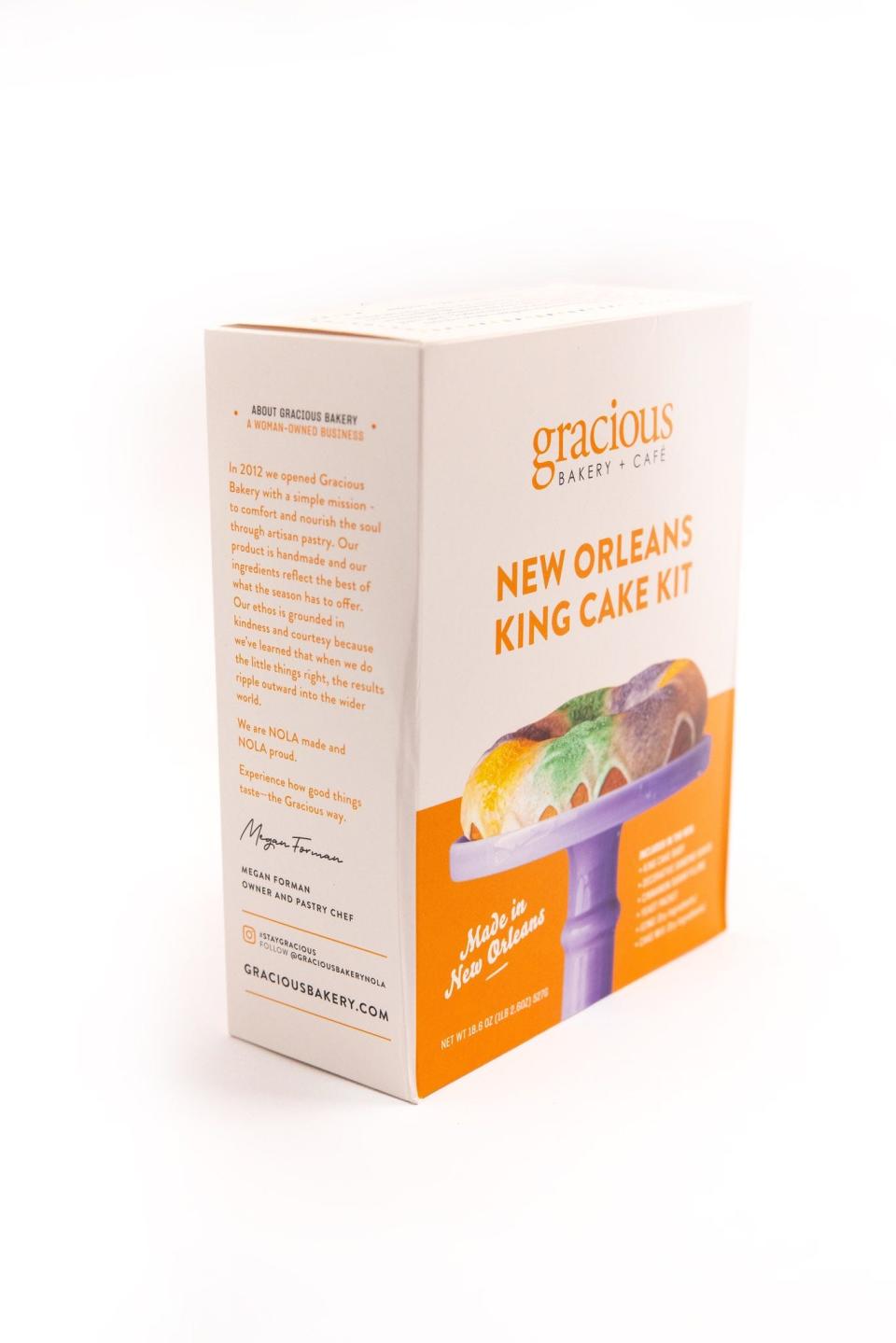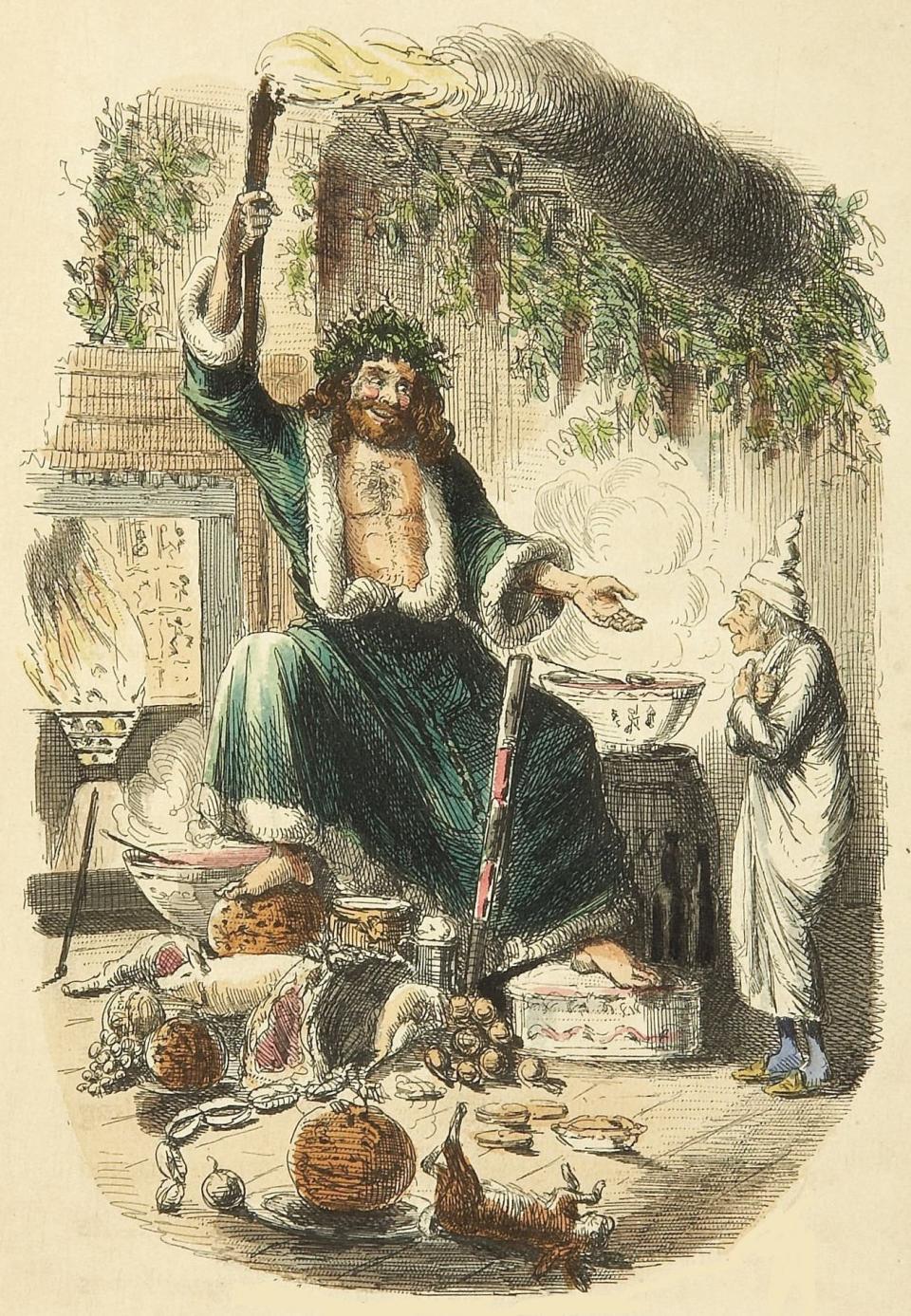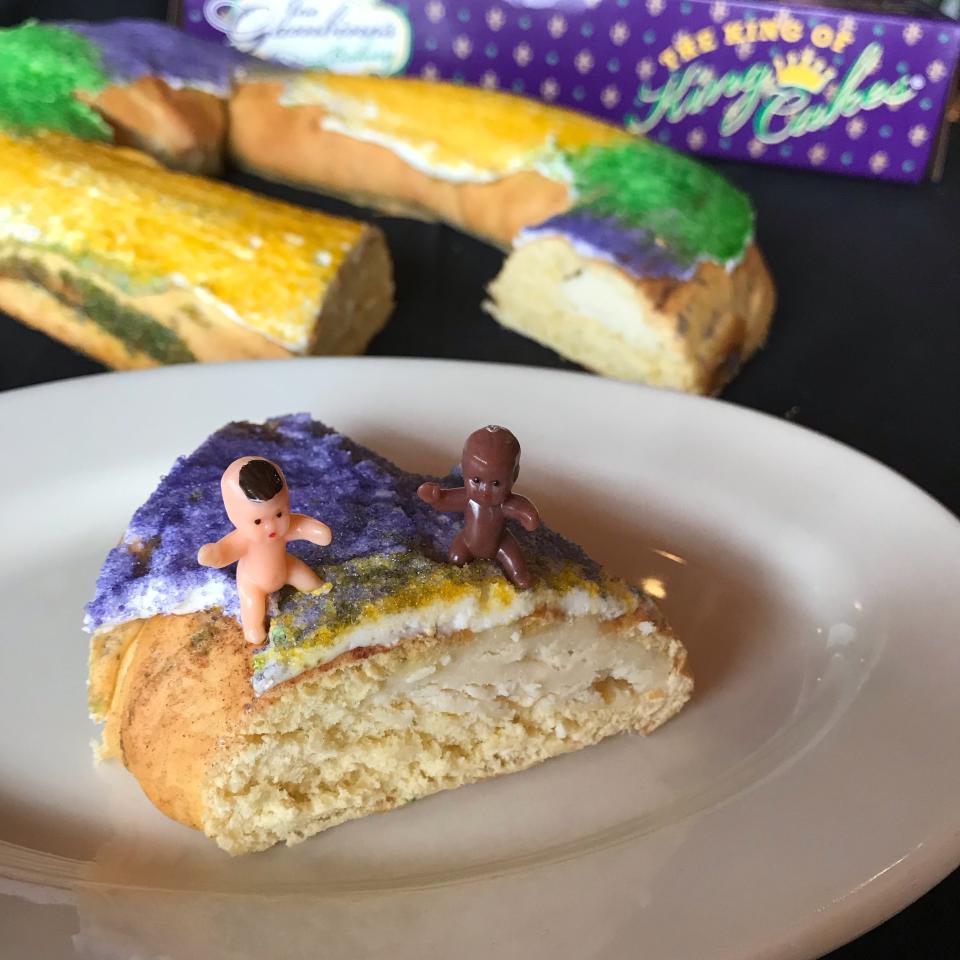King Cake: a Mardi Gras treat with lots of meaning — and a tiny baby — baked in
Among life's pleasures, there are a few that cannot be endorsed by the Child Safety Council.
One of these is king cake.
If you live in one of those lucky states, like Louisiana or Alabama, that celebrate Mardi Gras — observed, this year, on Tuesday, March 1 — you know all about king cake.
More: Talk the talk for Mardi Gras: here's a New Orleans dictionary
Also At Mardi Gras time, this Waldwick artist is the carnival queen
And: "Io Saturnalia!" Do we owe our Christmas customs to a pagan holiday?
Typically, it's a large pastry, somewhat like a coffee ring. It is iced with the Mardi Gras colors: purple, green and gold. And nestled somewhere in the depths of that delicious, doughy cake is a tiny plastic baby. Surprise!
What could possibly go wrong?
Actually, reports of children having to get their stomach pumped, as a result of swallowing the little token, seem to be mostly urban legends. Everyone has heard of someone it happened to. But never anyone they knew.
"I don't know any stories," said Carl Mack, founder of the Mardi Gras Museum of Costumes and Culture, celebrating its sixth year in New Orleans. "I did cut a baby in half the other day, slicing a king cake."

Traumatic enough: considering that the little figure is supposed, by some, to represent the Baby Jesus.
Whatever it's meant to be, it can cause mischief.
"Every year, it seems I get one or two people who say, 'I broke my tooth on it,' " said Angelo Cartozzo of Cartozzo's Bakery, which has been supplying king cakes to the revelers of New Orleans since 1960. He's heard stories about babies devoured by accident. Mostly from the litigious, he believes.
"You still hear, 'I swallowed the baby, my son swallowed the baby,' " Cartozzo said. "Everybody's looking for a quick buck."
These days, many bakeries in Louisiana leave the plastic baby on the outside, for the customer to insert. "They put the baby on top of the king cake, and you are responsible for hiding it inside one of the slices," Mack said. "It's because of liability."
According to custom
King cakes are part of the food lore of New Orleans. But in recent decades, they've been making their way North — not least because of the many homesick Louisiana expatriates who send away for them.
Bakeries like Gambino's, Caluda's and Brennan's do a huge mail-order business, in addition to their local patrons. New Jersey is actually a big market; in the mid-1980s, when Louisiana's oil industry hit a bad patch, many locals came to Jersey to work in ours. A good portion of his business, Cartozzo said, still comes from the Garden State. "Fifteen percent is New Jersey," he said.
Meanwhile, tri-state area bakeries are starting to make them, too. And of course, you can always make your own. Recipes are easy to come by, and cake mixes are commercially available.

"People enjoy getting them with different fillings, jam and other things," Mack said. "It's kind of a competition, who has the best king cake in town. There's a lot of pride."
The many fillings, and flavor variations, are a late-breaking development. Cream cheese, chocolate, cinnamon, fruit flavors (not to mention bacon and other such culinary experiments) can jazz up the taste of a king cake.
But some purists insist this is beside the point.
Like a fortune cookie, king cake is a vehicle, not an end in itself. What matters is the thing inside.
Hide and seek
The cake with the hidden token is an old tradition — older than New Orleans.
Many countries have variations: "roscón de reyes" (Spain), "bolo-rei" (Portugal) "dreikönigskuchen" (Germany) "galette des rois" (France).
As confections, they're all different. The French version is a puff pasty filled with almond custard — frangipane. The German variation is shaped like a sunflower. But each of them has a tiny something baked into it. An almond, in Germany. A fava bean, in France — which came to call these little trinkets "fèves" (fava beans). Eventually, "fèves" became little charms — rings and tiny toys — highly collectable in some circles.
Most of these cakes, you will note, have "reyes" or "roi" in the name. Which is to say, king.
The king cake, in all countries, is associated with Jan. 6, the Feast of Epiphany — the day when Caspar, Melchior and Balthazar, the three wise men, are supposed to have first set eyes on the baby Jesus. King cake, as in The Three Kings.
"And they see this child and they have an epiphany — the whole universe makes sense," Mack said. "That's why it's called Epiphany."
In other words, the king cake's true lineage is not Mardi Gras, but Christmas — which, you'll recall, originally lasted 12 days. The climax was January 6: Twelfth Night.
The English version of the king cake was known as a twelfth cake. When Ebenezer Scrooge first sees the Ghost of Christmas Present, he is sitting on a throne of "mince-pies, plum-puddings, barrels of oysters, red-hot chestnuts, cherry-cheeked apples, juicy oranges luscious pears, immense twelfth-cakes, and seething bowls of punch."

Nor did the English stop at cake. They were also fond, at Christmastime, of burying prizes in puddings. George Orwell, in 1946, described the inevitable result: "The darkening of the windows and the entry of the flaming plum pudding; the hurry to make sure that everyone has a piece on his plate while the brandy is still alight; the momentary panic when it is rumoured that Baby has swallowed the threepenny bit."
Over the last century or two, Christmas has dwindled to one day: December 25. Thus Twelfth Night — once so important that Shakespeare named a play after it — has lost its significance in many cultures. But not in New Orleans.
"On January 6, we roll right out of Christmas and New Year's and roll right into Carnival," said Jennifer Samuels, co-founder of King Cake Hub, a one-stop king cake shop (they have two New Orleans locations) that sells inventory from 16 local bakeries.
You can get Nutella king cakes, bananas foster king cakes, Almond Joy king cakes, raspberry and strawberry cheesecake-filled king cakes. Name your pleasure.
"The amazing thing is the spirit of this city," she said. "We will celebrate everything."
Carnival time
In The Big Easy, January 6 is when the fun begins.
It is both the end of Christmas, and the beginning of the carnival season. Which is likely how king cake — at some point long ago — strayed from its Christmas orbit and was pulled, like an asteroid, into the Mardi Gras trajectory.
The purple, green and gold cake (the colors stand for justice, faith and power) sets the stage for the four to eight weeks of madness leading up to Fat Tuesday — that last day of feasting, parading, masking and merrymaking before Lent.
It's a crazy time. Increasingly so, as the season goes on. There are parties every weekend. And one of the features, at each party, is the king cake that is shared among the guests. Whoever gets the slice with the baby is king or queen for the day.
The tiny baby — so central to the tradition these days — appears to be a late-breaking development.
Originally, in Louisiana, a bean or a pecan was used. Then, in the late 1930s, it seems a baker named Donald Entringer purchased a lot of tiny porcelain dolls from a salesman, and began to use them in the cakes he sold in his McKenzie’s bakery chain. It caught on.
Eventually, plastic was substituted for the porcelain — another reason many bakeries no longer cook the baby into the cake. "The baby would sometimes melt," Cartozzo said. "That cant be good."
And the winner is...?
So what happens if, at a party, you're the lucky stiff who finds the little baby?

Well, there's some good news, and some bad news.
The good news is that, as the king or queen of the party, you're heir to all the privileges appertaining thereto. You get a little paper crown (many bakeries supply them, with the cake, as lagniappe — "a little something extra.") Whenever you raise your glass to drink, everybody is supposed to shout "le roi boit!" — "the king drinks!"
On the other hand, noblesse has its oblige.
As king or queen of the carnival, you are required to buy the next king cake for the next party or office get-together.
"Hopefully, you're not the dirtbag who gets it and won't admit it," Samuels said. "Every office has one of those people. You always hear about those offices where, funny, nobody got the baby."
Each king cake purchase thus begets others. No wonder bakers love them.
"It cranks up after Christmas and it just builds and builds," Cartozzo said. "Every week it gets bigger and bigger until Mardi Gras. The last two weeks are almost insane. We can't make enough."
The climax, of course, is Mardi Gras itself. Some people, like Mack, throw a king cake breakfast, before they go out to catch beads and ride on floats. "We'd have guests come to the house Mardi Gras morning, and we'd serve king cake and champagne," Mack said. "That's a great way to have a party."
It all ends, of course, at the stroke of midnight. At which point, the carnival season is over — and Lent has begun.
One thing many people probably don't have much difficulty giving up: king cake.
"A week or two later, you can't give a king cake away," Cartozzo said.
Jim Beckerman is an entertainment and culture reporter for NorthJersey.com. For unlimited access to his insightful reports about how you spend your leisure time, please subscribe or activate your digital account today.
Email: beckerman@northjersey.com
Twitter: @jimbeckerman1
This article originally appeared on NorthJersey.com: Mardi Gras 2022 King Cake has layers of meaning

